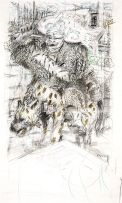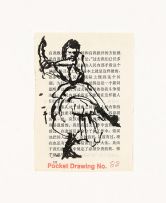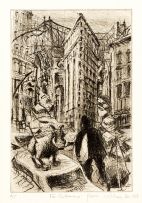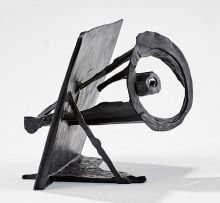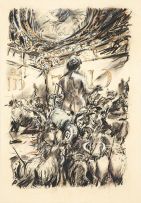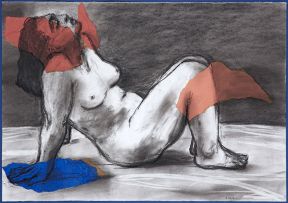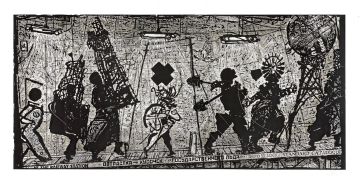Important South African and International Art
Live Auction, 9 November 2015
Session 2
Incl. Buyer's Premium & VAT
About this Item
signed
Notes
In 1986, while still living in Bertrams, a suburb east of Johannesburg's CBD, William Kentridge produced a print portfolio loosely based on William Hogarth's series of engravings Industry and Idleness (1747). Kentridge's portfolio of prints, which shares the same name, includes a satirical portrait of a drunk who becomes the "Lord Mayor of Derby Road". Kentridge modelled his wrinkled black protagonist in heavy coat and sash on a homeless man who drank methylated spirits and lived with a group of outcasts near his home.1 Sometimes referred to as "Harry" in writings, lectures and interviews, he was a recurring figure in Kentridge's early drawings, notably Arc/Procession: Develop, Catch Up, Even Surpass (1990), which includes the hyena. Harry also appears in the animated films Monument (1990) and Woyzeck on the Highveld (1992), as well as Kentridge's 1991 etchings series Little Morals.
In 1990, while preparing for a synchronous solo exhibition of drawings and graphics at Cassirer Fine Art and Gallery on the Market, both in Johannesburg, Kentridge spoke of a recent visit by Harry to his home: "… he was dressed in a Salvation Army general's jacket complete with sashes and epaulettes, as if he were dressed to model for Goya. You sometimes get these moments of confirmation, reassurances that what you are doing is not completely up the wall."2 While based on a real-world encounter, Kentridge's undated drawing is highly stylised: it is fabulist's version of the truth. Any social commentary here is contingent on an appreciation that the figure of the drunk is also a modern stand-in for the clown, a long-established trope in art. "I'm essentially interested in an art that is political but which allows an ambiguous politics, an art that encompasses as many ambiguities and contradictions as there are," remarked Kentridge during the 1990 interview in which he discussed Harry.3
1. Bronwyn Law-Viljoen (ed.), (2006), William Kentridge Prints, Johannesburg: David Krut Publishing. Page 30
2. Ivor Powell, 'Kentridge's Free-floating Art of Ambiguities', Weekly Mail, 26 April 1990.
3. Ibid.

